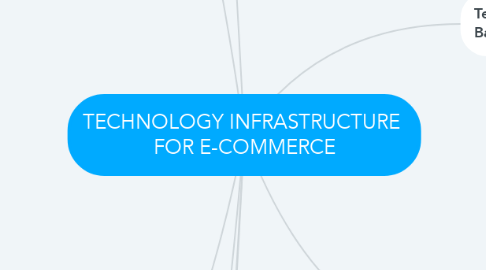
1. reduces costs of
1.1. Building and operating Web sites
1.2. Infrastructure, IT support
1.3. Hardware, software
2. Technology Background
2.1. Internet
2.1.1. Interconnected network of thousands of networks and millions of computers
2.2. World Wide Web
2.2.1. Web pages are created using HTML programming language; may contain text, graphic, audio, video, hyperlinks; navigated using web browser
2.3. The Evolution of the Internet
2.3.1. Innovation Phase, 1961 – 1974
2.3.1.1. Creation of fundamental building blocks of internet
2.3.1.2. packet switching, TCP/IP, client/server computing
2.3.2. Institutionalization Phase, 1975 – 1995
2.3.2.1. Tim Berners Lee proposes World Wide Web based on HTML pages
2.3.2.2. 1993 – First graphical web browser called Mosaic was invented by Marc Andreessen
2.3.2.3. 1994 – First commercial web browser called Netscape was invented by Marc Andreessen and Jim Clark
2.3.2.4. 1994 – the beginning of E-COMMERCE
2.3.3. Commercialization Phase, 1995 – present
2.3.3.1. Private corporations take over, expand Internet backbone and local service
2.3.3.2. 1995 – Jeffrey Preston Bezos (Jeff Bezos) founder of Amazon, Pierre Omidyar founder of eBay
3. Key Technology Concepts
3.1. Packet Switching
3.1.1. a process that slices digital messages into packets
3.1.2. Reassembles packets once they arrive at destination
3.1.3. Uses routers
3.1.3.1. ensure packets take the best available path toward their destination
3.1.3.2. Less expensive, wasteful than circuit switching
3.2. Transmission Control Protocol (TCP)
3.2.1. protocol that establishes connections among sending and receiving Web computers
3.2.2. dividing electronic message into info
3.2.3. New Topic
3.3. Internet Protocol (IP)
3.3.1. unique address to each computer on the internet
3.3.2. protocol that provides the Internet’s addressing scheme
3.3.3. TCP/IP layers
3.3.3.1. Network Interface Layer
3.3.3.2. Internet Layer
3.3.3.3. Transport Layer
3.3.3.4. Application Layer
3.4. Internet Protocols and Utility Programs
3.4.1. Simple Mail Transfer Protocol(smtp)
3.4.1.1. send e-mail to a server.
3.4.2. Post Office Protocol 3 (POP3)
3.4.2.1. retrieve mail
3.4.3. Internet Message Access Protocol (IMAP)
3.4.3.1. Search email
3.4.4. File Transfer Protocol (FTP)
3.4.4.1. transfer files from a server
3.4.5. Telnet
3.4.5.1. allow remote login on another computer.
3.4.6. Secure Sockets Layer (SSL) / Transport Layer Security (TLS)
3.4.6.1. operate between the transport and application layer of TCP/IP and secure communications
3.4.7. Packet InterNet Groper (Ping)
3.4.7.1. check the connection between a client computer and TCP/IP network
3.4.8. Tracert
3.4.8.1. Trace message
3.4.9. HyperText Markup Language (HTML)
3.4.9.1. standard markup language for creating web pages and web applications
3.4.10. Extensible Markup Language. XML
3.4.10.1. designed to store and transport data
3.4.11. Web server software
3.4.11.1. enables a computer/server to deliver web pages written in HTML that request this service by sending a HTTP request
3.4.12. Web client
3.4.12.1. device attached to the internet that is capable of making HTTP request and display HTML pages
3.4.13. Web browser
3.4.13.1. a software program whose primary purpose is to display web pages
3.4.13.2. user views web pages that contain text, image & other multimedia and navigates between them using hyperlinks.
3.4.13.3. ❖Netscape ❖ Opera ❖ Safari (for Apple) ❖ Google Chrome
3.4.14. Internet Service Providers (ISPs)
3.4.14.1. firm that provides the lowest level of service
3.5. IP Address
3.5.1. unique string of numbers
3.5.2. to communicate over a network
3.5.3. Current version: IPv4, IPv6
3.6. Domain name
3.6.1. IP address expressed in natural language
3.6.2. exampl.com
3.7. Domain name system (DNS)
3.7.1. Allows numeric IP addresses to be expressed in natural language
3.7.2. Cnet.com (cnet.com’s numeric IP is 216.239.113.101).
3.8. Uniform resource locator (URL)
3.8.1. Address used by Web browser to identify location of content on the Web
3.8.2. https://www.example.com
3.9. Client/Server Computing
3.9.1. clients connected in network with one or more servers
3.9.2. Servers perform common functions for the clients
3.9.3. Mobile computing
3.9.3.1. Netbooks
3.9.3.1.1. Designed to connect to wireless Internet
3.9.3.2. Smartphones
3.9.3.2.1. Disruptive technology: Processors, operating systems
3.9.4. Cloud Computing
3.9.4.1. storing and accessing data and programs over the Internet instead of storing in computer's hard drive
4. Intranets and Extranets
4.1. Intranet
4.1.1. intranet is a private network
4.1.2. Between inside organization only
4.2. Extranet
4.2.1. firms permit outsiders to access their internal TCP/IP networks
5. Network Architecture
5.1. Backbone
5.1.1. high bandwidth fiber optic cable that transports data across the internet
5.1.1.1. Fiber Optic Cable
5.1.1.1.1. designed for long distance, high-performance data networking, and telecommunications
5.2. Bandwidth
5.2.1. measures how much data can be transferred over a communications medium within a fixed period of time
5.3. Internet Exchange Points (IXPs)
5.3.1. hub where the backbone intersects with local and regional networks
5.3.2. backbone owners connect with one another
6. Internet Web Features
6.1. E-mail
6.1.1. enable messages containing text , images, sound, and video clips to be transferred
6.2. Instant messaging
6.2.1. displays words typed on a computer almost instantaneously
6.3. Search engines
6.3.1. typed by the user and then provides a list of the best matches.
6.4. Online forums
6.4.1. communicate with each other, although not in real time. Also referred as message board, bulletin board, discussion board, discussion group)
6.5. Streaming media
6.5.1. enables music, video, and other large files to be sent to users in chunks so that when received and played, the file comes through uninterrupted
6.6. Cookies
6.7. Online chat
6.7.1. communicate via computer in real time, that is, simultaneously
6.7.2. stored information about a user
6.8. Online Social Networks
6.8.1. Facebook, Google+, LinkedIn, Twitter, Pinterest
6.9. Intelligent agents (bots)
6.9.1. gather and/or filters information on a specific topic and then provides a list of results for the user.
6.10. Blog
6.10.1. communicate with readers.
6.11. Really Simple Syndication (RSS)
6.11.1. allows user to have digital content, including text, article, blogs, and podcast audio files , automatically sent to their computers over internet.
6.12. Podcast
6.12.1. audio presentation
6.13. Wiki
6.13.1. allows a user to easily add and edit content on a web page.
6.14. Internet Telephony
6.14.1. to transmit voice and other form of audio communication over the internet.
6.15. Voice over Internet Protocol (VoIP)
6.15.1. transmission of voice and other forms of audio communication over the internet.
